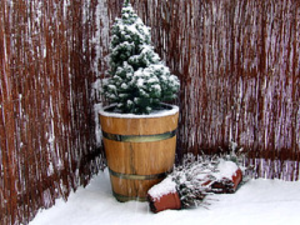Winterize Your Irrigation System in 3 Steps
 Even if you don’t live in an area that endures extremely cold temperatures, it’s important to winterize your landscape to prevent damage to plants and to protect your equipment. In this post, we’ll focus on the 3 steps you need to take to winterize your irrigation system.
Even if you don’t live in an area that endures extremely cold temperatures, it’s important to winterize your landscape to prevent damage to plants and to protect your equipment. In this post, we’ll focus on the 3 steps you need to take to winterize your irrigation system.
Here in the Pacific Northwest, we generally experience hard freezes in the early morning hours. As an irrigation services expert can tell you, the danger of not winterizing your system is that if water freezes inside it, the components of the system could crack and break. Since water expands as it freezes, the PVC and polyethylene piping that is often used for building irrigation systems can crack if water freezes inside. If you leave water in your irrigation sprinkler system over the winter, you risk costly repairs this spring.
For homeowners who are comfortable working with home irrigation systems, follow the steps listed below to clear your irrigation system of all water before the coldest weather arrives. If you don’t have the time or expertise to take care of this on your own, call an irrigation services provider to winterize your irrigation sprinkler system for you.
3-Step Winterizing Process
1. Shut Off The Water
The first thing you need to do is locate and turn off the main water valve that’s running to your irrigation system. The main valve should be protected from freezing temperatures; it’s usually located inside an irrigation box buried in the ground below the frost line. Alternatively, it may be wrapped with protective insulation or be located in your home basement. If you don’t have a main shut-off valve for your irrigation system have an irrigation services provider install one for you.
2. Deactivate The System
The majority of irrigation sprinkler systems are automated, offering convenience to homeowners and making the daily watering schedule hassle-free.
Irrigation controllers come in two main types–those with a digital readout and those with a manual turning dial. Set digital controllers to the “Off” position for the winter months. When a system is in the “Off” mode, all power is cut off to the valves in the irrigation system while still maintaining the controllers programming information for next season.
If your irrigation controller features a dial somewhat similar to a clock face with no digital readout, turn off the power to the controller to save energy. Unlike digital controllers, manual controllers have no programmed settings that can be lost when power is off.
3. Drain Remaining Water
There are many parts of your irrigation/sprinkling system that must be completely emptied of water before the winter months. There are three basic methods to removing water from irrigation systems:
Manual Draining
Manual draining involves manually turning off all valves and shaking out any extra water from sprinkler parts. Manual valves are typically located at the end and low points of irrigation systems. Open all valves, let the water drain out, and make sure to also drain any water between the system’s shutoff valve and the backflow device. (Backflow devices prevent the pollution of drinking water by stopping backflow from irrigation lines to potable water lines.) The cocks on the backflow device should also be opened, as well as any valves located on individual sprinklers. If your sprinklers do not have valves installed on them, you may need to actually shake each sprinkler until all the water comes out.
Manual draining is rarely recommended except for the most experienced homeowners since water can remain trapped in the system even after you’ve drained as many valves as possible. Most people who are knowledgeable about irrigation services recommend calling in a professional to conduct “blow out” draining instead.
Automatic Draining
Some systems are equipped with automatic draining. For these systems, drainage automatically occurs when pressure in the system falls below 10 PSI. To completely remove remaining water follow the steps listed above to check for water between the shutoff valve and the backflow device, and for removing water from sprinkler heads.
Blow-out Draining
Blow-out draining uses compressed air to blow all extra water out of irrigation systems. When done properly this is a very effective method. However, blow-out draining can cause damage if done incorrectly. To protect your system it’s best to call an irrigation services professional to blow-out your irrigation system.
Protect Your Investment
Winterizing irrigation systems is generally more time-consuming in climates that experience deep soil freezes. In some (more temperate) climates draining off water from underground components may not be necessary. If you’re not sure what’s recommended for your area or the best method for your particular system, call and speak with one of the irrigation experts at Landscape East and West.
